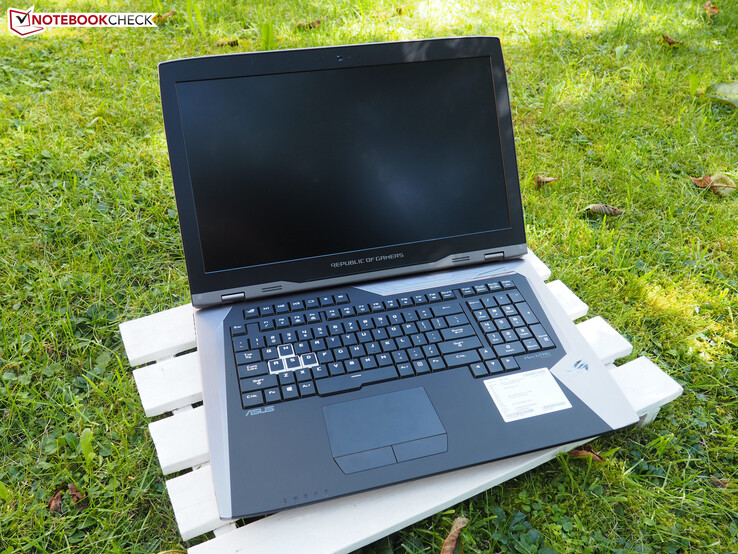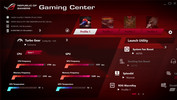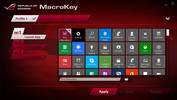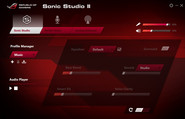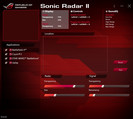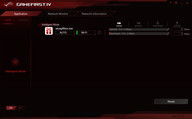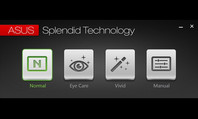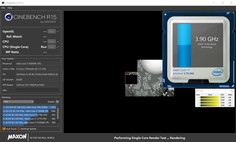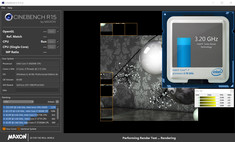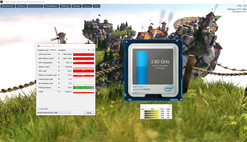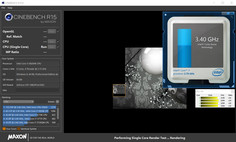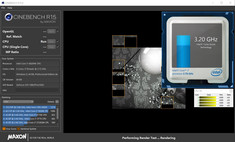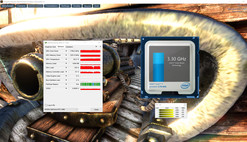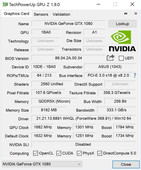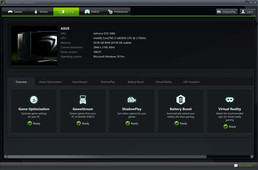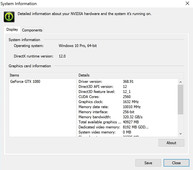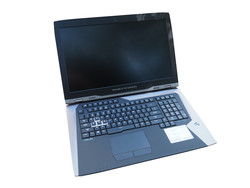Asus ROG G800VI Notebook Preview
Asus is the right choice if you are looking for a gaming platform with a big screen and a lot of performance. Besides the SLI notebook GX800, which is equipped with water cooling, the manufacturer will also launch an 18-inch notebook with a single GPU for Nvidia's Pascal launch. It does not need the Hydro Overclocking Station and is designed to be an alternative to the popular G752.
Asus has equipped the G800 with a lot of technology to justify the high retail price. Up to 64 GB DDR4 of RAM and up to three PCIe/NVMe-SSDs in RAID 0 are just as generous as an UHD display with 3840x2160 pixels. The package is rounded off with a factory overclocked Core i7-6820HK (more on this later) and the most powerful notebook GPU currently available. The GeForce GTX 1080 is supposed to be on par with its desktop counterpart and should manage identical performance figures under optimal conditions. This article will find out whether this statement is true.
Overview
Unfortunately, there is not much to say about the case, input devices, the emissions and the power consumption because our review unit is a prototype based on the chassis of the GX800 (including the components for the water cooling). The shown pictures are therefore not representative of the final product. On the other hand, the performance and the components – except for the panel type – of our pre-sample should be pretty meaningful. Asus does at least want to deliver a similar performance at the launch in Autumn 2016.
Like its 5.7 kg (~13 lb) 18-inch sibling GX800, the first thing you will notice after the boot is the Gaming Center with its completely new design. Not only can you configure the dedicated auxiliary keys, but also the keyboard illumination and the fan behavior via additional apps.
The most important element is the Turbo Gear option, which controls the clocks of the CPU and GPU, respectively, in different modes. The "Extreme" preset results in very high clocks. While the Core i7-6820HK is accelerated up to 3.9 GHz (default: 2.7-3.6 GHz), the video memory of the GeForce GTX 1080 reaches up to 5200 MHz (default: 5000 MHz). The core of the DirectX-12 chip runs with 1682 to 1784 instead of 1632 to 1734 MHz – hence, 50 MHz more.
The Pascal architecture was, however, designed to manage even higher clocks depending on the cooling capabilities of the system. According to the GPU-Z Render test, the GTX 1080 manages almost 1900 MHz. The core will level off at around 1800 MHz in practice (quick check with Unigine Heaven benchmark), but the results are still great compared to the Maxwell generation. The previous top model GeForce GTX 980, for example, runs at a maximum of only 1200 MHz.
Performance
We have included several screenshots (CPU, RAM, storage, …) to give you an idea of the potential hardware components of the G800.
Processor
Unlike most manufacturers, Asus does not use a Core i7-6700HQ (2.6 to 3.5 GHz, 6 MB L3-cache) for its high-end notebook, but instead, the more expensive Skylake sibling Core i7-6820HK with 8 MB L3-cache, a free multiplier as well as a 100 MHz higher base clock. The TDP is 45 watts in both cases and the integrated Intel HD Graphics 530 chip. However, the G800 does not support Optimus, so the GeForce GTX 1080 is always active. This reduces allocation problems, but also increases the power consumption.
As mentioned before, the Core i7-6820HK reaches up to 3.9 GHz in the Extreme Mode, but we can only see 3.2 GHz in multi-core scenarios (could be a result of the prototype status).
The G800 still performs very well in the CPU benchmarks. Both Cinebench R11.5 as well as Cinebench R15 see the 18-inch system ahead of the 6820HK rival MSI GT72S. The Core i7-6700HQ notebooks Alienware 17 R3 and Asus G752VY are also beaten, while the desktop processor of the Schenker XMG U726 is in the lead by a few percent.
| Cinebench R11.5 | |
| CPU Single 64Bit | |
| Schenker XMG U726 | |
| Asus G800VI Prototype | |
| Alienware 17 R3 (A17-9935) | |
| Asus G752VY-RH71 | |
| MSI GT72S 6QF | |
| CPU Multi 64Bit | |
| Schenker XMG U726 | |
| Asus G800VI Prototype | |
| MSI GT72S 6QF | |
| Asus G752VY-RH71 | |
| Alienware 17 R3 (A17-9935) | |
System Performance
The performance of the G800 is particularly great in the system benchmarks. 7826 points in PCMark 7 is an excellent result, which can easily surpass the other comparison devices (deficit: 8 to 24%).
| PCMark 7 Score | 7826 points | |
Help | ||
Storage Devices
The high system scores are mainly a result of the storage devices. Asus has equipped our model with two PCIe-SSDs (500 GB each) in a RAID-0 configuration. We are therefore not surprised by the excellent sequential results of the 18-inch notebook in CrystalDiskMark. More than 3000 MB/s (read) and 2000 MB/s (write) were not possible a couple of years ago. Typical SATA-III-SSDs are limited at 500 to 550 MB/s. Subjectively, the G800 is extremely responsive in all aspects (application launches, loading times, data transfers, boot sequence).
| Asus G800VI Prototype | MSI GT72S 6QF 2x Micron M600 MTFDDAV128MBF NVMe (RAID 0) | Schenker XMG U726 Samsung SM951 MZHPV512HDGL m.2 PCI-e | Alienware 17 R3 (A17-9935) Samsung PM951 NVMe 512 GB | Asus G752VY-RH71 Samsung SSD 950 Pro 512GB m.2 NVMe | |
|---|---|---|---|---|---|
| AS SSD | -11% | -16% | -5% | ||
| Seq Read (MB/s) | 2895 | 2544 -12% | 1943 -33% | 2109 -27% | |
| Seq Write (MB/s) | 1537 | 1279 -17% | 1500 -2% | 1459 -5% | |
| 4K Read (MB/s) | 40.17 | 42.98 7% | 40.45 1% | 46.1 15% | |
| 4K Write (MB/s) | 114.3 | 97.8 -14% | 103.6 -9% | 120.9 6% | |
| Score Total (Points) | 3096 | 2568 -17% | 1930 -38% | 2705 -13% |
GPU Performance
In our opinion, the main attraction is the GeForce GTX 1080. Just like its desktop counterpart, the GPU is manufactured in a 16-nm process, supports DirectX 12 and is equipped with 2560 shader units as well as 8 GB VRAM. Unlike the GTX 1070 (2048 shader @laptop), however, the latter is not GDDR5, but GDDR5X. The memory interface is identical at 256-bit as well.
We can see small deviations in terms of clocks. While the Founders Edition of the desktop GTX 1080 is specified with 1607 to 1733 MHz, Asus allows the GPU to run at 1632 to 1734 MHz (not including the factory overclocking).
| 3DMark Vantage P Result | 47402 points | |
| 3DMark 11 Performance | 19596 points | |
| 3DMark Ice Storm Standard Score | 159315 points | |
| 3DMark Cloud Gate Standard Score | 28743 points | |
| 3DMark Fire Strike Score | 16217 points | |
| 3DMark Time Spy Score | 6255 points | |
Help | ||
Otherwise, the siblings are quite similar, which is also supported by our benchmarks. The GTX 1080 manages a GPU score of 21501 points in the 3DMark Fire Strike test and is therefore actually 2% faster than the desktop version (21154 points). A notebook GTX 1070 is beaten by 26%; the GTX 980 falls behind by 65% – even though the high-end Maxwell GPU only has 20% less CUDA cores. The difference compared to the very popular GTX 980M is even bigger since it is beaten by 100% in the Fire Strike test. The differences are similar in the other 3DMark versions.
| Unigine Heaven 4.0 - Extreme Preset DX11 | |
| Nvidia GeForce GTX 1080 Founders Edition | |
| Asus G800VI Prototype | |
| Nvidia GeForce GTX 1070 Founders Edition | |
| MSI GT62VR-6RE16H21 | |
| Schenker XMG U726 | |
Gaming Performance
Before we start to analyze the gaming performance, we want to talk about the driver. The device was shipped with the ForceWare 368.91, which was used for all synthetic benchmarks and Origin as well as Uplay games. Nvidia released ForceWare 372.53 just before we finished our measurements, so we only used it for the Steam games. Another test with 3DMark 13 and the Unigine Heaven 4.0 benchmark did not show any performance gains, so the different driver versions should not be a problem.
| Advantage of the GTX 1080(4K/High & FHD/Ultra) | Comparison GPU |
|---|---|
| -3 % vs. | GeForce GTX 1080 Desktop |
| +30 % vs. | GeForce GTX 1070 Notebook |
| +47 % vs. | GeForce GTX 980 Notebook |
| +113 % vs. | GeForce GTX 980M |
But back to the topic: As expected, the GeForce GTX 1080 can mix up the ranking and wins the title of "most powerful Notebook GPU". 1920x1080 pixels are usually not really a challenge for the high-end GPU, and it starts to get interesting at 3K and 4K resolutions. But the 16-nm still has sufficient performance reserves in almost every game. Even very demanding games such as “The Witcher 3”, “Call of Duty Black Ops 3” or “The Division” run pretty smoothly at high details and 3840x2160 pixels. This level of performance is not possible with a GPU from the Maxwell generation. Even the GTX 980 often dropped below 35 fps in our 4K setting.
| Mirror's Edge Catalyst | |
| 3840x2160 High Preset AF:16x | |
| Asus G800VI Prototype | |
| Nvidia GeForce GTX 1080 Founders Edition | |
| Nvidia GeForce GTX 1070 Founders Edition | |
| MSI GT62VR-6RE16H21 | |
| Asus GX800 Prototype | |
| Schenker W504 | |
| 1920x1080 Ultra Preset AF:16x | |
| Nvidia GeForce GTX 1080 Founders Edition | |
| Asus G800VI Prototype | |
| Nvidia GeForce GTX 1070 Founders Edition | |
| MSI GT62VR-6RE16H21 | |
| Asus GX800 Prototype | |
| Schenker W504 | |
| Overwatch | |
| 3840x2160 High (Render Scale 100 %) AA:SM AF:4x | |
| Nvidia GeForce GTX 1080 Founders Edition | |
| Asus G800VI Prototype | |
| Nvidia GeForce GTX 1070 Founders Edition | |
| MSI GT62VR-6RE16H21 | |
| Asus GX800 Prototype | |
| Schenker W504 | |
| 1920x1080 Epic (Render Scale 100 %) AA:SM AF:16x | |
| Nvidia GeForce GTX 1080 Founders Edition | |
| Asus G800VI Prototype | |
| Nvidia GeForce GTX 1070 Founders Edition | |
| MSI GT62VR-6RE16H21 | |
| Asus GX800 Prototype | |
| Schenker W504 | |
| Doom | |
| 3840x2160 High Preset AA:FX | |
| Asus G800VI Prototype | |
| Nvidia GeForce GTX 1080 Founders Edition | |
| Nvidia GeForce GTX 1070 Founders Edition | |
| MSI GT62VR-6RE16H21 | |
| Asus GX800 Prototype | |
| Schenker W504 | |
| 1920x1080 Ultra Preset AA:SM | |
| Asus G800VI Prototype | |
| Nvidia GeForce GTX 1080 Founders Edition | |
| Nvidia GeForce GTX 1070 Founders Edition | |
| MSI GT62VR-6RE16H21 | |
| Asus GX800 Prototype | |
| Schenker W504 | |
| Need for Speed 2016 | |
| 3840x2160 High / On AA:FX | |
| Nvidia GeForce GTX 1080 Founders Edition | |
| Asus G800VI Prototype | |
| MSI GT62VR-6RE16H21 | |
| Nvidia GeForce GTX 1070 Founders Edition | |
| Asus GX800 Prototype | |
| Schenker W504 | |
| 1920x1080 Ultra / On AA:T | |
| Nvidia GeForce GTX 1080 Founders Edition | |
| Nvidia GeForce GTX 1070 Founders Edition | |
| Asus GX800 Prototype | |
| Asus G800VI Prototype | |
| MSI GT62VR-6RE16H21 | |
| Schenker W504 | |
| Hitman 2016 | |
| 3840x2160 High / On AA:FX AF:8x | |
| Asus G800VI Prototype | |
| Nvidia GeForce GTX 1080 Founders Edition | |
| Nvidia GeForce GTX 1070 Founders Edition | |
| MSI GT62VR-6RE16H21 | |
| Asus GX800 Prototype | |
| Schenker W504 | |
| 1920x1080 Ultra / On AA:SM AF:16x | |
| Nvidia GeForce GTX 1080 Founders Edition | |
| Nvidia GeForce GTX 1070 Founders Edition | |
| Asus G800VI Prototype | |
| Asus GX800 Prototype | |
| MSI GT62VR-6RE16H21 | |
| Schenker W504 | |
| The Division | |
| 3840x2160 High Preset AF:8x | |
| Asus G800VI Prototype | |
| Nvidia GeForce GTX 1080 Founders Edition | |
| Nvidia GeForce GTX 1070 Founders Edition | |
| MSI GT62VR-6RE16H21 | |
| Asus GX800 Prototype | |
| 1920x1080 Ultra Preset AF:16x | |
| Asus G800VI Prototype | |
| Nvidia GeForce GTX 1080 Founders Edition | |
| Nvidia GeForce GTX 1070 Founders Edition | |
| MSI GT62VR-6RE16H21 | |
| Asus GX800 Prototype | |
| Schenker W504 | |
| Far Cry Primal | |
| 3840x2160 High Preset AA:SM | |
| Nvidia GeForce GTX 1080 Founders Edition | |
| Asus G800VI Prototype | |
| Nvidia GeForce GTX 1070 Founders Edition | |
| MSI GT62VR-6RE16H21 | |
| Asus GX800 Prototype | |
| Schenker W504 | |
| 1920x1080 Ultra Preset AA:SM | |
| Nvidia GeForce GTX 1080 Founders Edition | |
| Asus G800VI Prototype | |
| Nvidia GeForce GTX 1070 Founders Edition | |
| MSI GT62VR-6RE16H21 | |
| Asus GX800 Prototype | |
| Schenker W504 | |
| XCOM 2 | |
| 3840x2160 High Preset AA:FX AF:8x | |
| Asus G800VI Prototype | |
| Nvidia GeForce GTX 1080 Founders Edition | |
| Nvidia GeForce GTX 1070 Founders Edition | |
| MSI GT62VR-6RE16H21 | |
| Asus GX800 Prototype | |
| 1920x1080 Maximum Preset (8xMSAA instead of FXAA) AA:8xMS AF:16x | |
| Asus G800VI Prototype | |
| Nvidia GeForce GTX 1080 Founders Edition | |
| Nvidia GeForce GTX 1070 Founders Edition | |
| MSI GT62VR-6RE16H21 | |
| Asus GX800 Prototype | |
| Schenker W504 | |
| Rise of the Tomb Raider | |
| 3840x2160 High Preset AA:FX AF:4x | |
| Asus G800VI Prototype | |
| Nvidia GeForce GTX 1080 Founders Edition | |
| Nvidia GeForce GTX 1080 Founders Edition | |
| Nvidia GeForce GTX 1070 Founders Edition | |
| MSI GT62VR-6RE16H21 | |
| Asus GX800 Prototype | |
| Schenker W504 | |
| 1920x1080 Very High Preset AA:FX AF:16x | |
| Nvidia GeForce GTX 1080 Founders Edition | |
| Nvidia GeForce GTX 1080 Founders Edition | |
| Nvidia GeForce GTX 1080 Founders Edition | |
| Asus G800VI Prototype | |
| Nvidia GeForce GTX 1070 Founders Edition | |
| MSI GT62VR-6RE16H21 | |
| Asus GX800 Prototype | |
| Schenker W504 | |
| Just Cause 3 | |
| 3840x2160 High / On AA:FX AF:8x | |
| Nvidia GeForce GTX 1080 Founders Edition | |
| Asus G800VI Prototype | |
| Nvidia GeForce GTX 1070 Founders Edition | |
| Schenker W504 | |
| 1920x1080 Very High / On AA:SM AF:16x | |
| Nvidia GeForce GTX 1080 Founders Edition | |
| Nvidia GeForce GTX 1070 Founders Edition | |
| Asus G800VI Prototype | |
| MSI GT62VR-6RE16H21 | |
| Schenker W504 | |
| Rainbow Six Siege | |
| 3840x2160 High Preset AA:T AF:4x | |
| Nvidia GeForce GTX 1080 Founders Edition | |
| Asus G800VI Prototype | |
| Nvidia GeForce GTX 1070 Founders Edition | |
| MSI GT62VR-6RE16H21 | |
| Schenker W504 | |
| 1920x1080 Ultra Preset AA:T AF:16x | |
| Nvidia GeForce GTX 1080 Founders Edition | |
| Asus G800VI Prototype | |
| Nvidia GeForce GTX 1070 Founders Edition | |
| MSI GT62VR-6RE16H21 | |
| Schenker W504 | |
| Assassin's Creed Syndicate | |
| 3840x2160 High Preset AA:FX | |
| Nvidia GeForce GTX 1080 Founders Edition | |
| Asus G800VI Prototype | |
| Nvidia GeForce GTX 1070 Founders Edition | |
| MSI GT62VR-6RE16H21 | |
| Schenker XMG U716 | |
| Schenker W504 | |
| 1920x1080 Ultra High Preset AA:4x MSAA + FX | |
| Nvidia GeForce GTX 1080 Founders Edition | |
| Asus G800VI Prototype | |
| Nvidia GeForce GTX 1070 Founders Edition | |
| MSI GT62VR-6RE16H21 | |
| Schenker XMG U716 | |
| Schenker W504 | |
| Star Wars Battlefront | |
| 3840x2160 High Preset AA:FX | |
| Nvidia GeForce GTX 1080 Founders Edition | |
| Asus G800VI Prototype | |
| Nvidia GeForce GTX 1070 Founders Edition | |
| MSI GT62VR-6RE16H21 | |
| Schenker XMG U716 | |
| Schenker W504 | |
| 1920x1080 Ultra Preset AA:FX | |
| Nvidia GeForce GTX 1080 Founders Edition | |
| Asus G800VI Prototype | |
| Nvidia GeForce GTX 1070 Founders Edition | |
| MSI GT62VR-6RE16H21 | |
| Schenker XMG U716 | |
| Schenker W504 | |
| Fallout 4 | |
| 3840x2160 High Preset AA:T AF:16x | |
| Nvidia GeForce GTX 1080 Founders Edition | |
| Asus G800VI Prototype | |
| Nvidia GeForce GTX 1070 Founders Edition | |
| MSI GT62VR-6RE16H21 | |
| Schenker XMG U716 | |
| Schenker W504 | |
| 1920x1080 Ultra Preset AA:T AF:16x | |
| Nvidia GeForce GTX 1080 Founders Edition | |
| Asus G800VI Prototype | |
| Nvidia GeForce GTX 1070 Founders Edition | |
| MSI GT62VR-6RE16H21 | |
| Schenker XMG U716 | |
| Schenker W504 | |
| Call of Duty: Black Ops 3 | |
| 3840x2160 High / On AA:FX | |
| Nvidia GeForce GTX 1080 Founders Edition | |
| Asus G800VI Prototype | |
| Nvidia GeForce GTX 1070 Founders Edition | |
| MSI GT62VR-6RE16H21 | |
| Schenker XMG U716 | |
| Schenker W504 | |
| 1920x1080 Extra / On AA:T2x SM | |
| Nvidia GeForce GTX 1080 Founders Edition | |
| Asus G800VI Prototype | |
| Nvidia GeForce GTX 1070 Founders Edition | |
| MSI GT62VR-6RE16H21 | |
| Schenker XMG U716 | |
| Schenker W504 | |
| Anno 2205 | |
| 3840x2160 High Preset AA:4x | |
| Nvidia GeForce GTX 1080 Founders Edition | |
| Asus G800VI Prototype | |
| Nvidia GeForce GTX 1070 Founders Edition | |
| MSI GT62VR-6RE16H21 | |
| Schenker XMG U716 | |
| Schenker W504 | |
| 1920x1080 Ultra High Preset AA:8x | |
| Nvidia GeForce GTX 1080 Founders Edition | |
| Asus G800VI Prototype | |
| Nvidia GeForce GTX 1070 Founders Edition | |
| MSI GT62VR-6RE16H21 | |
| Schenker XMG U716 | |
| Schenker W504 | |
| FIFA 16 | |
| 3840x2160 High Preset AA:2x MS | |
| Nvidia GeForce GTX 1080 Founders Edition | |
| Asus G800VI Prototype | |
| MSI GT62VR-6RE16H21 | |
| Schenker XMG U716 | |
| Schenker W504 | |
| 1920x1080 High Preset AA:4x MS | |
| Asus G800VI Prototype | |
| Schenker XMG U716 | |
| MSI GT62VR-6RE16H21 | |
| Schenker W504 | |
| Mad Max | |
| 3840x2160 High Preset AF:6x | |
| Asus G800VI Prototype | |
| Nvidia GeForce GTX 1080 Founders Edition | |
| Nvidia GeForce GTX 1070 Founders Edition | |
| Schenker XMG U716 | |
| Schenker W504 | |
| 1920x1080 Very High Preset AF:12x | |
| Asus G800VI Prototype | |
| Nvidia GeForce GTX 1080 Founders Edition | |
| Nvidia GeForce GTX 1070 Founders Edition | |
| MSI GT62VR-6RE16H21 | |
| Schenker XMG U716 | |
| Schenker W504 | |
| Batman: Arkham Knight | |
| 3840x2160 High / On (Interactive Smoke & Paper Debris Off) AA:SM AF:8x | |
| Asus G800VI Prototype | |
| MSI GT62VR-6RE16H21 | |
| Schenker XMG U716 | |
| Schenker W504 | |
| 1920x1080 High / On AA:SM AF:16x | |
| Asus G800VI Prototype | |
| MSI GT62VR-6RE16H21 | |
| Schenker XMG U716 | |
| Schenker W504 | |
| The Witcher 3 | |
| 3840x2160 High Graphics & Postprocessing (Nvidia HairWorks Off) | |
| Nvidia GeForce GTX 1080 Founders Edition | |
| Asus G800VI Prototype | |
| Nvidia GeForce GTX 1070 Founders Edition | |
| MSI GT62VR-6RE16H21 | |
| Schenker XMG U716 | |
| Schenker W504 | |
| 1920x1080 Ultra Graphics & Postprocessing (HBAO+) | |
| Nvidia GeForce GTX 1080 Founders Edition | |
| Asus G800VI Prototype | |
| Nvidia GeForce GTX 1070 Founders Edition | |
| MSI GT62VR-6RE16H21 | |
| Schenker XMG U716 | |
| Schenker W504 | |
| Dirt Rally | |
| 3840x2160 High Preset | |
| Nvidia GeForce GTX 1070 Founders Edition | |
| Nvidia GeForce GTX 1080 Founders Edition | |
| Asus G800VI Prototype | |
| Schenker XMG U716 | |
| Schenker W504 | |
| 1920x1080 Ultra Preset AA:4x MS | |
| Nvidia GeForce GTX 1070 Founders Edition | |
| Nvidia GeForce GTX 1080 Founders Edition | |
| Asus G800VI Prototype | |
| Schenker XMG U716 | |
| MSI GT62VR-6RE16H21 | |
| Schenker W504 | |
| Dragon Age: Inquisition - 1920x1080 Ultra Graphics Quality AA:2x MS | |
| Nvidia GeForce GTX 1080 Founders Edition | |
| Asus G800VI Prototype | |
| Nvidia GeForce GTX 1070 Founders Edition | |
| MSI GT62VR-6RE16H21 | |
| Schenker XMG U716 | |
| One K73-5N | |
| Alien: Isolation - 1920x1080 Ultra, On, Shadow Map 2048, HDAO AA:2x SM AF:16x | |
| Asus G800VI Prototype | |
| Nvidia GeForce GTX 1080 Founders Edition | |
| Nvidia GeForce GTX 1070 Founders Edition | |
| MSI GT62VR-6RE16H21 | |
| Schenker XMG U716 | |
| One K73-5N | |
| Sims 4 - 1920x1080 Ultra Preset | |
| Asus G800VI Prototype | |
| Schenker XMG U716 | |
| One K73-5N | |
| MSI GT62VR-6RE16H21 | |
| GRID: Autosport - 1920x1080 Ultra Preset AA:4x MS | |
| Asus G800VI Prototype | |
| Schenker XMG U716 | |
| MSI GT62VR-6RE16H21 | |
| Watch Dogs - 1920x1080 Ultra Overall Quality, Ultra Textures AA:4x MS | |
| Asus G800VI Prototype | |
| Schenker XMG U716 | |
| MSI GT62VR-6RE16H21 | |
| One K73-5N | |
| Thief - 1920x1080 Very High Preset AA:FXAA & High SS AF:8x | |
| Asus G800VI Prototype | |
| Schenker XMG U716 | |
| MSI GT62VR-6RE16H21 | |
| Battlefield 4 | |
| 3840x2160 High Preset | |
| Asus G800VI Prototype | |
| Nvidia GeForce GTX 1080 Founders Edition | |
| Nvidia GeForce GTX 1070 Founders Edition | |
| MSI GT62VR-6RE16H21 | |
| Schenker XMG U716 | |
| Schenker W504 | |
| 1920x1080 Ultra Preset AA:4x MS | |
| Nvidia GeForce GTX 1080 Founders Edition | |
| Asus G800VI Prototype | |
| Nvidia GeForce GTX 1070 Founders Edition | |
| MSI GT62VR-6RE16H21 | |
| Schenker XMG U716 | |
| Metro: Last Light - 1920x1080 Very High (DX11) AF:16x | |
| Nvidia GeForce GTX 1080 Founders Edition | |
| Asus G800VI Prototype | |
| Nvidia GeForce GTX 1070 Founders Edition | |
| MSI GT62VR-6RE16H21 | |
| Schenker XMG U716 | |
| BioShock Infinite - 1920x1080 Ultra Preset, DX11 (DDOF) | |
| Nvidia GeForce GTX 1080 Founders Edition | |
| Asus G800VI Prototype | |
| Nvidia GeForce GTX 1070 Founders Edition | |
| MSI GT62VR-6RE16H21 | |
| Schenker XMG U716 | |
| Crysis 3 - 1920x1080 Very High Preset AA:2xSM AF:16x | |
| Nvidia GeForce GTX 1080 Founders Edition | |
| Asus G800VI Prototype | |
| Nvidia GeForce GTX 1070 Founders Edition | |
| MSI GT62VR-6RE16H21 | |
| Schenker XMG U716 | |
It is therefore very interesting how the GTX 1080 will affect the prices. Main rival AMD does not really have an alternative, so Nvidia can pretty much dictate the price. The GTX 1070 and the GTX 1060 will most probably sell much better. Pascal leaves a very sophisticated impression from a technological point of view. We hardly faced crashes, graphics errors or other bugs independent of the driver version. Only “Assassin’s Creed Syndicate” refused to run in fullscreen. More information about the Pascal architecture is available in our dedicated article.
| low | med. | high | ultra | 4K | |
|---|---|---|---|---|---|
| Crysis 3 (2013) | 98.7 | ||||
| BioShock Infinite (2013) | 174 | ||||
| Metro: Last Light (2013) | 133 | ||||
| Battlefield 4 (2013) | 172 | 90.2 | |||
| Thief (2014) | 113 | ||||
| Watch Dogs (2014) | 75.1 | 74.5 | |||
| GRID: Autosport (2014) | 161 | 131 | |||
| Sims 4 (2014) | 173 | 141 | |||
| Alien: Isolation (2014) | 270 | 229 | |||
| Dragon Age: Inquisition (2014) | 150 | 111 | |||
| Dirt Rally (2015) | 145 | 125 | 118 | ||
| The Witcher 3 (2015) | 139 | 74.2 | 51 | ||
| Batman: Arkham Knight (2015) | 141 | 96 | 56 | ||
| Mad Max (2015) | 242 | 223 | 82.1 | ||
| FIFA 16 (2015) | 291 | 201 | |||
| Anno 2205 (2015) | 114 | 56.3 | 66.8 | ||
| Call of Duty: Black Ops 3 (2015) | 144 | 140 | 56.9 | ||
| Fallout 4 (2015) | 141 | 121 | 52.5 | ||
| Star Wars Battlefront (2015) | 183 | 164 | 66.2 | ||
| Assassin's Creed Syndicate (2015) | 85 | 52.9 | 47.2 | ||
| Rainbow Six Siege (2015) | 226 | 203 | 81.8 | ||
| Just Cause 3 (2015) | 105 | 99.7 | 58.6 | ||
| Rise of the Tomb Raider (2016) | 134 | 109 | 50.1 | ||
| XCOM 2 (2016) | 92.6 | 51.3 | 30.9 | ||
| Far Cry Primal (2016) | 114 | 101 | 48 | ||
| The Division (2016) | 121 | 96.3 | 49.4 | ||
| Hitman 2016 (2016) | 71.9 | 67.9 | 45.7 | ||
| Need for Speed 2016 (2016) | 96.3 | 76.7 | 59.4 | ||
| Doom (2016) | 142 | 140 | 65.8 | ||
| Overwatch (2016) | 287 | 195 | 104 | ||
| Mirror's Edge Catalyst (2016) | 129 | 117 | 47.4 |
Verdict
At this very early stage, we do not evaluate the G800, but primarily focus on the performance aspect instead. Nvidia's GeForce GTX 1080 is an extremely powerful notebook GPU and technically identical to its desktop counterpart. Depending on the cooling capabilities, this is also the case for the performance.
Users of the last GPU generation will be very jealous about the benchmark results. Maxwell does not stand a chance against Pascal in any benchmark. The GTX 1080 is about 50% faster than a GTX 980 and more than twice as fast as the GTX 980M. Thanks to the 16 nm architecture (previously 28 nm); neither the heat development nor the power consumption is necessarily higher. The MSI GT62VR with the GTX 1070 shows the efficiency of Pascal quite impressively.
The GeForce GTX 1080 is also one of the few notebook GPUs we would call 4K-ready. 1920x1080 pixels are absolutely no problem for the high-end chip. All 31 tested games exceeded 50 fps even with the maximum settings and multiple anti-aliasing. If you cannot get enough frames per second in UHD, you should also have a look at the SLI system in the GX800.





